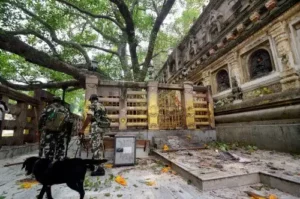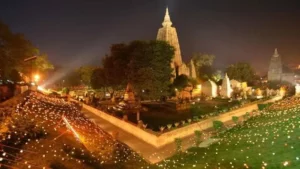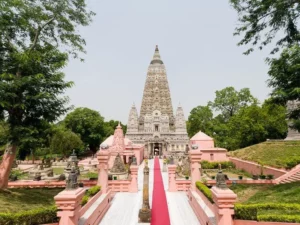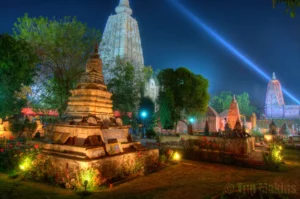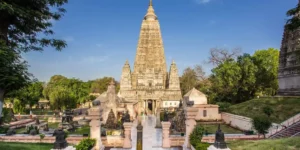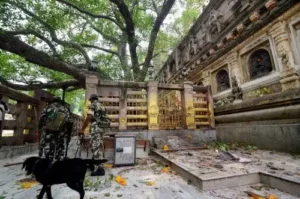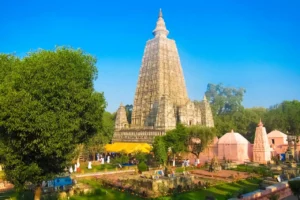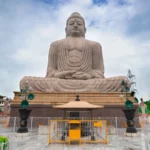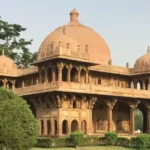Nestled in the town of Bodh Gaya, India, the Mahabodhi Temple stands as a profound testament to spiritual enlightenment and architectural splendor. With its origins tracing back to ancient times, this temple holds an enduring place in the hearts of Buddhists and travelers from around the world. This article delves into the captivating history, architectural marvels, spiritual essence, and practical aspects of visiting the Mahabodhi Temple.
- History of Mahabodhi Temple
- Architectural Marvel of Mahabodhi Temple
- Spiritual Significance and Pilgrimage
- The Sacred Bodhi Tree
- Rituals and Practices
- Cultural and Artistic Heritage
- Surrounding Attractions
- How to Reach Mahabodhi Temple
- Best Time to Visit Mahabodhi Temple
- Accommodation and Facilities
- Local Cuisine and Souvenirs
- Community and Social Initiatives
- Future of Mahabodhi Temple
- Conclusion
- FAQs about Mahabodhi Temple
History of Mahabodhi Temple
The roots of the Mahabodhi Temple extend deep into history, dating back to the 3rd century BCE. It was Emperor Ashoka who first recognized the significance of this site and erected a shrine here to commemorate the enlightenment of Siddhartha Gautama, later known as Buddha. Over the centuries, the temple has undergone numerous renovations and expansions, each contributing to its majestic presence today.
Architectural Marvel of Mahabodhi Temple
The Mahabodhi Temple showcases a harmonious blend of various architectural styles, including Gupta, Mauryan, and later additions from different eras. The main temple structure stands tall with its intricate carvings, depicting scenes from the life of Buddha and various deities. The grandeur of its torana (ornamental arch) and the serene aura of the temple courtyard create an atmosphere of reverence and awe.
Spiritual Significance and Pilgrimage
Designated as a UNESCO World Heritage Site, the Mahabodhi Temple holds immense spiritual significance for Buddhists. It marks the very spot where Gautama Buddha attained enlightenment under the Bodhi tree. This momentous event reverberates through time, drawing countless pilgrims to engage in prayer, meditation, and self-discovery. The temple’s serene ambiance and historical weight make it a global center for Buddhist practices and philosophical exploration.
The Sacred Bodhi Tree
Central to the temple complex is the sacred Bodhi tree, an offspring of the original tree under which Buddha attained enlightenment. Its lush canopy provides shade to visitors, while the tree’s roots intertwining with history evoke a sense of continuity and connection with the past.
Rituals and Practices
The Mahabodhi Temple is a hub of spiritual rituals and practices. Devotees engage in chanting, meditation, and circumambulation, fostering a sense of mindfulness and inner tranquility. The rhythmic cadence of prayer wheels and the aroma of incense infuse the air with an aura of devotion.
Cultural and Artistic Heritage
The temple’s influence extends beyond spirituality into the realms of art, literature, and culture. Its architectural motifs have inspired artists for centuries, and its teachings have permeated literature, philosophy, and contemporary thought. The temple complex also houses a treasure trove of ancient manuscripts, sculptures, and artifacts, offering a glimpse into the past.
Surrounding Attractions
While the Mahabodhi Temple stands as the crown jewel of Bodh Gaya, the surrounding area is adorned with attractions that further enrich the visitor’s experience. The Great Buddha Statue, Bodhi Sarovar, and Sujata Kuti are among the notable sites that provide a holistic journey through history and spirituality.
How to Reach Mahabodhi Temple
Reaching the Mahabodhi Temple is convenient, with several transportation options available. The temple is well-connected by road, rail, and air, with Gaya Airport serving as the nearest major gateway. Travelers can opt for buses, trains, or domestic flights to access this spiritual haven.
Best Time to Visit Mahabodhi Temple
To fully savor the tranquility and avoid large crowds, consider visiting the Mahabodhi Temple during the off-peak seasons. The months of October to March offer pleasant weather, allowing visitors to explore the temple complex and its surroundings comfortably.
Accommodation and Facilities
A range of accommodation options caters to the diverse needs of visitors. From budget guesthouses to luxurious resorts, Bodh Gaya offers a variety of lodgings in close proximity to the Mahabodhi Temple. Additionally, the town provides essential amenities, ensuring a convenient and comfortable stay.
Local Cuisine and Souvenirs
Exploring Bodh Gaya’s local cuisine is an adventure in itself. Delight your taste buds with traditional dishes that reflect the flavors of the region. Don’t forget to savor local specialties and bring back edible souvenirs that capture the essence of Bodh Gaya.
Community and Social Initiatives
The Mahabodhi Temple complex actively engages with local communities, contributing to the region’s socio-economic development. Initiatives aimed at education, healthcare, and sustainable tourism create a positive impact and enrich the experience of visitors who seek not only spiritual enrichment but also meaningful interactions with the local culture.
Future of Mahabodhi Temple
As a custodian of history and spirituality, the Mahabodhi Temple faces the dual challenge of preservation and adaptation. Continued efforts are required to maintain its architectural integrity and cultural legacy while embracing modern advancements in visitor experience. Balancing tradition and innovation will shape the temple’s future as a timeless sanctuary for generations to come.
Conclusion
The Mahabodhi Temple stands as a living testament to humanity’s pursuit of enlightenment and self-discovery. Its rich history, architectural grandeur, and spiritual aura combine to create a truly transformative experience. Whether you seek sol
FAQs about Mahabodhi Temple
Yes, the temple is open to people of all faiths and beliefs. It holds a universal appeal that transcends religious boundaries.
While there is no strict dress code, it’s advisable to dress modestly out of respect for the sacred surroundings.
Yes, the temple often hosts meditation sessions and retreats, allowing visitors to engage in mindfulness practices.
The Bodhi tree symbolizes the site of Buddha’s enlightenment and is revered as a source of spiritual awakening.
Photography is usually allowed, but it’s important to be mindful of your surroundings and the spiritual atmosphere.
Embark on a transformative journey to the Mahabodhi Temple, where history, spirituality, and architectural marvels converge in a harmonious symphony. Witness the timeless legacy that continues to inspire and uplift countless souls across the globe.
